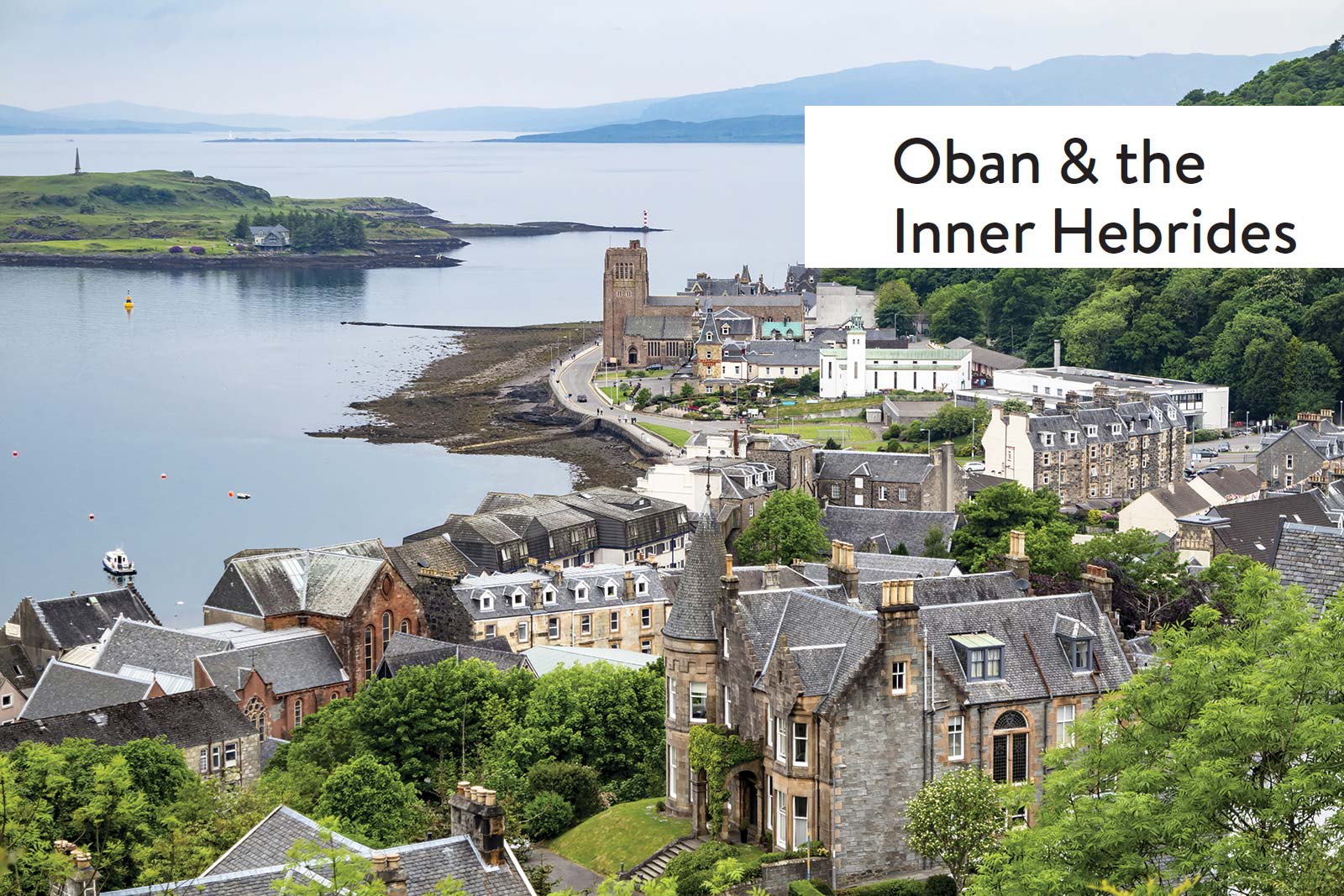
Oban & the Inner Hebrides at a Glance
OBAN & THE INNER HEBRIDES IN 2 DAYS
Map: Oban & the Inner Hebrides
Map: Glencoe & Fort William Area
Glencoe Valley Driving (and Hiking) Tour
For a taste of Scotland’s west coast, the port town of Oban is equal parts endearing and functional. This busy little ferry-and-train terminal has no important sights, but makes up the difference in character, in scenery (with its low-impact panorama of overlapping islets and bobbing boats), and with one of Scotland’s best distillery tours. Oban is also convenient: It’s midway between the Lowland cities (Glasgow and Edinburgh) and the Highland riches of the north (Glencoe, Isle of Skye). And it’s the “gateway to the isles,” with handy ferry service to the Hebrides Islands.
Oban is ideally situated for a busy and memorable full-day side-trip to three of the most worthwhile Inner Hebrides: big, rugged Mull; pristine little Iona, where buoyant clouds float over its historic abbey; and Staffa, a remote, grassy islet inhabited only by sea birds. (The best of the Inner Hebrides—the Isle of Skye—is covered in its own chapter.) Sit back, let someone else do the driving, and enjoy a tour of the Inner Hebrides.
You’ll need two nights to enjoy Oban’s main attraction: the side-trip to Mull, Iona, and Staffa. There are few actual sights in Oban itself, beyond the excellent distillery tour, but—thanks to its manageable size, scenic waterfront setting, and great restaurants—the town is an enjoyable place to linger.
Drivers coming from Glasgow can follow a scenic route via Inveraray (see here), arrive in Oban by midday, get oriented to the town, and take the distillery tour (and visit more sights as time allows). Devote the next day to visiting the islands.
Evening options in Oban include dinner at a seafood restaurant, live traditional music at pubs, music and dancing at Skipinnish Ceilidh House, a movie at the Phoenix Cinema, or a waterfront stroll.
Oban (pronounced OH-bin) is a low-key resort. Its winding promenade is lined by gravel beaches, ice-cream stands, fish-and-chips joints, a tourable distillery, and a good choice of restaurants. Everything in Oban is close together, and the town seems eager to please its many visitors: Wool and tweed are perpetually on sale, and posters announce a variety of day tours to Scotland’s wild and wildlife-strewn western islands. When the rain clears, sun-starved Scots sit on benches along the Esplanade, leaning back to catch some rays. Wind, boats, gulls, layers of islands, and the promise of a wide-open Atlantic beyond give Oban a rugged charm.
Oban, with about 10,000 people, is where the train system of Scotland meets the ferry system serving the Hebrides Islands. As “gateway to the isles,” its center is not a square or market, but its harbor. Oban’s business action, just a couple of streets deep, stretches along the harbor and its promenade.
Tourist Information: Oban’s TI, located at the North Pier, sells bus and ferry tickets, is well stocked with brochures, and has free Wi-Fi (generally daily July-Aug 9:00-19:00; April-June 9:00-17:30; Sept-March 10:00-17:00; 3 North Pier, tel. 01631/563-122, www.oban.org.uk).
Laundry: You’ll find Oban Quality Laundry tucked a block behind the main drag just off Stevenson Street (same-day drop-off service, no self-service, Mon-Fri 9:00-17:00, Sat until 13:00, closed Sun, tel. 01631/563-554). The recommended Backpackers Plus hostel (here) will also do laundry for nonguests.
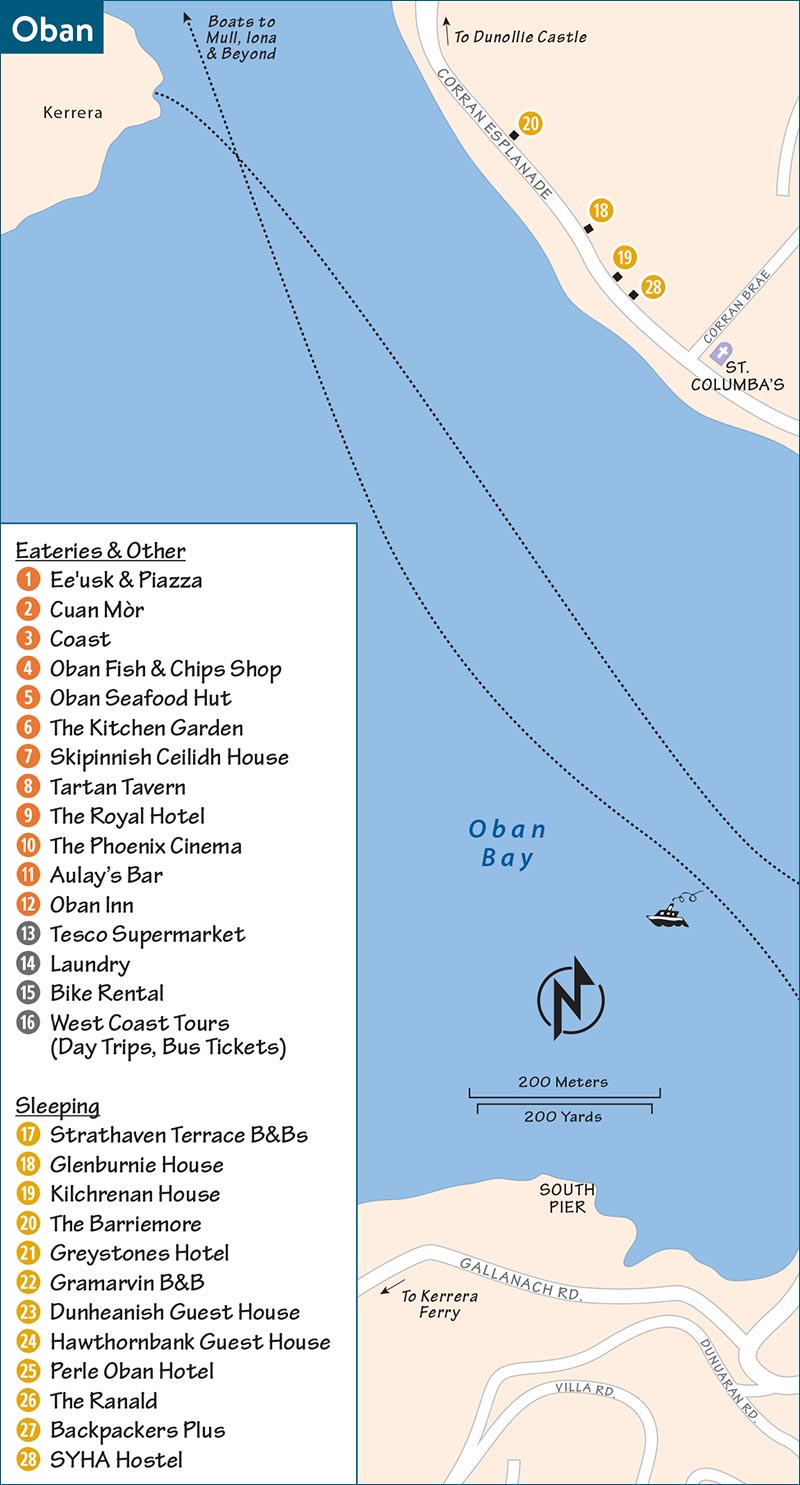
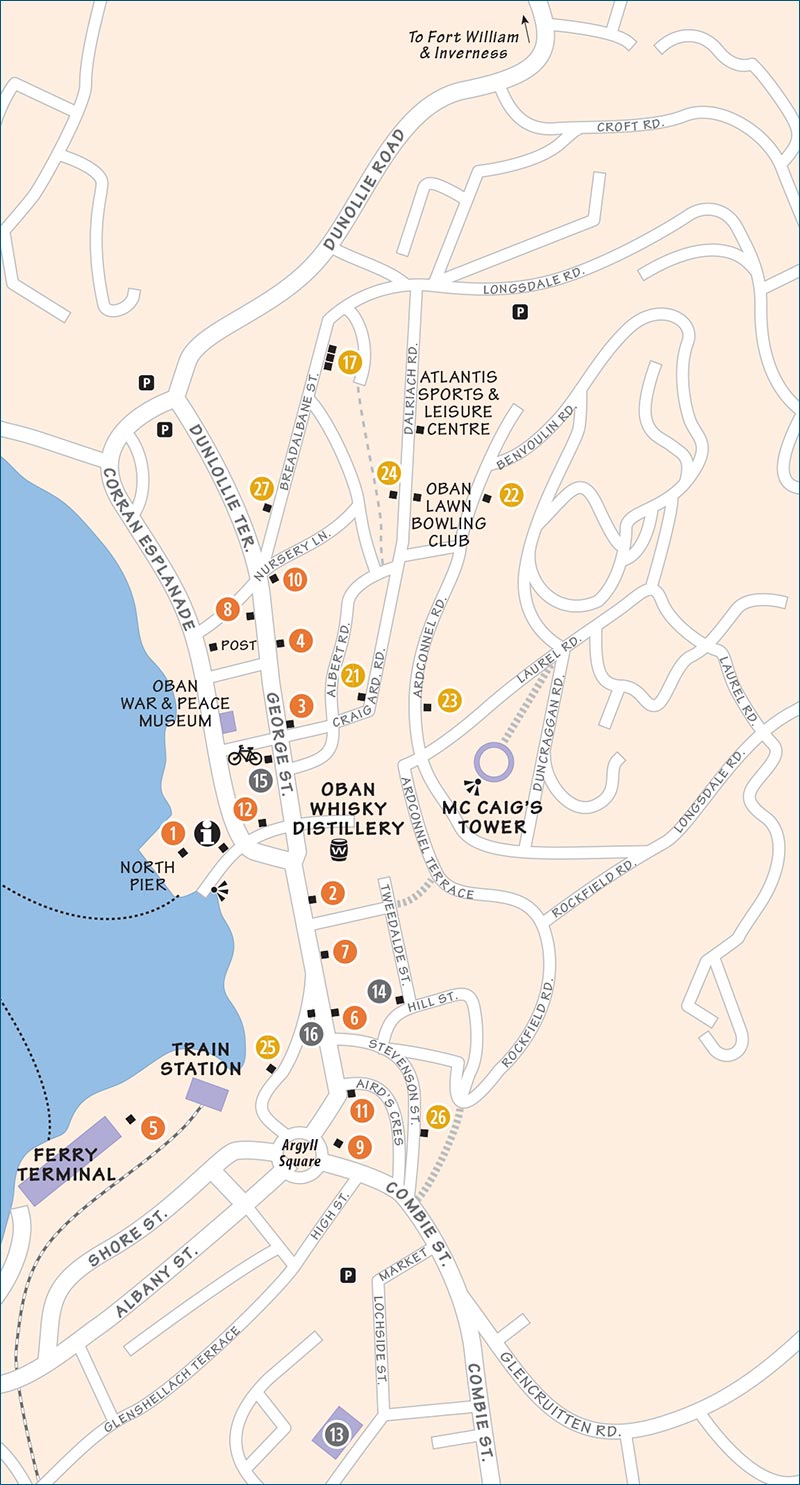

Supermarket: The giant Tesco is a five-minute walk from the train station (Mon-Sat until 24:00, Sun until 20:00, walk through Argyll Square and look for entrance to large parking lot on right, Lochside Street).
Bike Rental: Oban Cycles is on the main drag (£25/day, Tue-Sat 10:00-17:00, closed Sun-Mon, 87 George Street, tel. 01631/566-033).
Rick’s Tip: If leaving Oban by bus in peak season, it’s wise to book bus tickets the day before—either at the TI, or at the West Coast Tours office.
Bus and Island Tour Tickets: West Coast Tours, a block from the train station in the bright-red building along the harbor, sells bus and island tour tickets (Tue-Sat 6:30-17:30, Sun-Mon 8:30-17:30, 17 George Street, tel. 01631/566-809, www.westcoasttours.co.uk).
Highland Games: Oban hosts its touristy Highland Games every August (www.obangames.com), and the more local-oriented Lorne Highland Games each June (www.lorne-highland-games.org.uk).
For the best day trip from Oban, tour the islands of Mull, Iona, and/or Staffa (offered daily Easter-Oct, described later). With more time or other interests, consider one of many other options you’ll see advertised.
If you just want to go for a boat ride, the easiest option is the one-hour seal-watching tour (£10, various companies—look for signs at the harbor). But to really get a good look at Scottish coastal wildlife, several groups—including Coastal Connection (based in Oban) and Sealife Adventures and SeaFari (based in nearby coastal towns)—run whale-watching tours that seek out rare minke whales, basking sharks, bottlenose dolphins, and porpoises. For an even more ambitious itinerary, the holy grail is Treshnish Island (out past Staffa), which brims with puffins, seals, and other sea critters. Options abound—check at the TI for information.
If the weather is good and you don’t have a car, you can go by bus for a spin out of Oban for views of nearby castles and islands, plus a stop near McCaig’s Tower with narration by the driver (£7, departs train station 4/day June-Sept only, 1.5 hours, www.citysightseeingoban.com).
▲THE BURNED-OUT SIGHTSEER’S VISUAL TOUR FROM THE PIER
▲▲OBAN WHISKY DISTILLERY TOURS
If weather permits, get oriented to the town while taking a break: Head out to the North Pier, just past the TI, and find the benches that face back toward town (in front of the recommended Piazza restaurant). Take a seat and get to know Oban.
Scan the harborfront from left to right, surveying the mix of grand Victorian sandstone buildings and humbler modern storefronts. At the far-right end of town is the ferry terminal and—very likely—a huge ferry loading or unloading. The townscape seems dominated by Caledonian MacBrayne, Scotland’s biggest ferry company. CalMac’s 30 ships serve 24 destinations and transport more than 4 million passengers a year. The town’s port has long been a lifeline to the islands.
Hiding near the ferry terminal is the train station. With the arrival of the train in 1880, Oban became the unofficial capital of Scotland’s west coast and a destination for tourists.
Tourism aside, herring was the first big industry. A dozen boats still fish commercially—you’ll see them tucked around the ferry terminal.
After fishing, big industries here historically included tobacco (imported from the American colonies), then whisky. At the left end of the embankment, find the building marked Oban Whisky Distillery. With the success of its whisky, the town enjoyed an invigorating confidence, optimism, and, in 1811, a royal charter. Touring Oban’s distillery is the best activity in Oban.
Above the distillery, you can’t miss the odd mini-Colosseum. This is McCaig’s Tower, an employ-the-workers-and-build-me-a-fine-memorial project undertaken by an Oban tycoon in 1900. McCaig died before completing the structure, so his complete vision for it remains a mystery. This is an example of a “folly”—that uniquely British notion of an idiosyncratic structure erected by a colorful aristocrat. While the building itself is nothing to see up close, a 10-minute hike through a Victorian residential neighborhood leads you to a peaceful garden and a commanding view (nice at sunset).
Now turn and look out to sea, and imagine this: At the height of the Cold War, Oban played a critical role when the world’s first two-way transatlantic telephone cable was laid from Gallanach Bay to Newfoundland in 1956—a milestone in global communication. This technology later provided the White House and the Kremlin with the “hotline” that was created after the Cuban Missile Crisis to avoid a nuclear conflagration.
Founded in 1794, Oban Whisky Distillery produces more than 25,000 liters a week, and exports much of that to the US. Their exhibition (upstairs, free to all) gives a quick, whisky-centric history of Oban and Scotland.
The distillery offers serious and fragrant one-hour tours explaining the process from start to finish, with two smooth samples of their signature product: Oban whisky is moderately smoky (“peaty”) and characterized by notes of sea salt, citrus, and honey. You’ll also receive a whisky glass and a discount coupon for the shop. This is the handiest whisky tour you’ll encounter—just a block off the harbor—and one of the best. Arrive 10 minutes before your tour starts to check out the exhibition upstairs. Then your guide will walk you through each step of the process: malting, mashing, fermentation, distillation, and maturation. Photos are not allowed inside.
Cost and Hours: Tours cost £10, are limited to 16 people and depart every 20 to 30 minutes. Tours fill up, so book in advance by phone, online, or in person to get a firm spot. Unless it’s really a busy day, you should be able to drop in and pay for a tour leaving in the next hour or so, then easily pass time in the town center. Generally open July-Sept Mon-Fri 9:30-19:30, Sat-Sun until 17:00; March-June and Oct-Nov daily 9:30-17:30; Dec-Feb daily 12:30-16:00; last tour 1.25 hours before closing, Stafford Street, tel. 01631/572-004, www.discovering-distilleries.com.
Serious Tasting: Connoisseurs can ask about their “exclusive tour,” which adds a visit to the warehouse and four premium tastings in the manager’s office (£40, 2 hours, likely July-Sept, Mon, Wed, and Fri at 16:00 only, reservation required).
Opened in 1995 on the 50th anniversary of Victory in Europe Day, this charming little museum focuses on Oban’s experience during World War II. But it covers more than just war and peace. Photos show Oban through the years, and a 15-minute looped video gives a simple tour around the town and region. Volunteer staffers love to chat about the exhibit—or anything else on your mind (free; May-Oct Mon-Sat 10:00-18:00, Sun until 16:00; off-season daily until 16:00; next to Regent Hotel on the promenade, tel. 01631/570-007, www.obanmuseum.org.uk).
In a park just a mile up the coast, a ruined castle and an old house hold an intimate collection of clan family treasures. This spartan, stocky castle with 10-foot walls offers a commanding, windy view of the harbor—a strategic spot back in the days when transport was mainly by water. For more than a thousand years, clan chiefs ruled this region from this ancestral home of Clan MacDougall, but the castle was abandoned in 1746. The adjacent house, which dates from 1745, shows off the MacDougall clan’s heritage with a handful of rooms filled with a humble yet fascinating trove of treasures. While the exhibit won’t dazzle you, the family and clan pride in the display, their “willow garden,” and the walk from Oban make the visit fun.
To get there, head out of town along the harborfront promenade. At the war memorial (with inviting seaview benches), cross the street. A gate leads to a little lane, lined with historic and nature boards along the way to the castle.
Cost and Hours: £5.50, April-Oct Mon-Sat 10:00-16:00, Sun from 13:00, closed Nov-March, free tours given most days at 11:00 and 14:00, tel. 01631/570-550, www.dunollie.org.
This industrial-type sports center is a good place to get some exercise on a rainy day or let the kids run wild for a few hours. It has a rock-climbing wall, tennis courts, indoor “soft play centre” (for kids under 5), and an indoor swimming pool with a big water slide. The outdoor playground is free and open all the time. (Pool only-£4.20, no rental towels or suits, fees for other activities; open Mon-Fri 6:30-21:30, Sat-Sun 9:00-18:00; on the north end of Dalriach Road, tel. 01631/566-800, www.atlantisleisure.co.uk.)
The club has welcomed visitors since 1869. This elegant green is the scene of a wonderfully British spectacle of old men tiptoeing wishfully after their balls. It’s fun to watch, and—if there’s no match scheduled and the weather’s dry—anyone can rent shoes and balls and actually play (£5/person; informal hours, but generally daily 10:00-12:00 & 14:00-16:00 or “however long the weather lasts”; just south of sports center on Dalriach Road, tel. 01631/570-808, www.obanbowlingclub.com).
Functioning like a giant breakwater, the Isle of Kerrera (KEH-reh-rah) makes Oban possible. Just offshore from Oban, this stark but very green island offers a quick, easy opportunity to get that romantic island experience. In contrast, the isles of Mull, Iona, and Staffa are farther out and require a full day to visit (described later in this chapter). For a quicker glimpse at the Inner Hebrides, consider Kerrera.
While it has no proper roads, it offers nice hikes, a ruined castle, and a few sheep farms. It’s also a fine place to bike (ask for advice at bike rental shop). You may see the Kerrera ferry filled with sheep heading for Oban’s livestock market.
Getting There: You have two options for reaching the island. A boat operated by the Oban Marina goes from Oban’s North Pier to the Kerrera Marina in the northern part of the island (£5 round-trip, every two hours, book ahead at tel. 01631/565-333, www.obanmarina.com).
A ferry departs from Gallanach (two miles south of Oban) and goes to the middle of the island. This is the best option if you want to hike to Kerrera’s castle (passengers only, £4.50 round-trip, bikes free, runs 10:30-18:00 with a break 12:30-14:00, none in off-season, 5-minute ride, tel. 01475/650-397, www.calmac.co.uk. To reach Gallanach, drive south, following the coast road past the ferry terminal (parking available).
Eating on Kerrera: $$ Waypoint Bar & Grill has a laid-back patio with a simple menu of steak, burgers, and seafood. On a nice day the open-air waterside setting is unbeatable (late May-Sept Tue-Sun 18:00-21:00, bar opens at 17:00, closed Mon and in winter, reservations highly recommended, tel. 01631/565-333, www.obanmarina.com).
Little Oban has a few options for entertaining its many visitors; check www.obanwhatson.co.uk. Fun low-key activities may include open-mic, disco, or quiz theme nights in pubs; occasional Scottish folk shows; coffee meetings; and—if you’re lucky—duck races. On Wednesday nights, the Oban Pipe Band plays in the square by the train station.
Music and Group Dancing: On many summer nights, you can climb the stairs to the Skipinnish Ceilidh House, a sprawling venue on the main drag for music and dancing (the owners are professional musicians Angus and Andrew). There’s ceilidh (KAY-lee) dancing a couple of times per week, where you can learn some group dances to music performed by a folk band (including, usually, a piper). These group dances are a lot of fun—wallflowers and bad dancers are warmly welcomed, and the staff is happy to give you pointers (£8, May-Sept Mon & Thu at 21:00). They also host concerts by folk and traditional bands (check website for schedule, 34 George Street, tel. 01631/569-599, www.skipinnishceilidhhouse.com).
Traditional Music: Various pubs and hotels in town have live traditional music in the summer; ask your B&B host or the TI for the latest. Try the Tartan Tavern, a block off the waterfront at 3 Albany Terrace or The Royal Hotel, just above the train station on Argyll Square.
Cinema: The Phoenix Cinema is volunteer-run and booming (140 George Street, tel. 01631/562-905, www.obanphoenix.com).
Characteristic Pubs: Aulay’s Bar, with decor that shows off Oban’s maritime heritage, has two sides, each with a different personality (I like the right-hand side). Having a drink here invariably comes with a good “blether” (conversation), and the gang is local (daily 11:00-24:00, 8 Airds Crescent, just around the corner from the train station and ferry terminal). The Oban Inn, right on the harborfront, is also a fun and memorable place for a pint and possibly live music.
Oban brags that it is the “seafood capital of Scotland,” and indeed its sit-down restaurants (listed first) are surprisingly high quality for such a small town. For something more casual, consider a fish-and-chips joint.
These fill up in summer, especially on weekends. To ensure getting a table, you’ll want to book ahead. The first four are generally open daily from 12:00-15:00 and 17:30-21:00.
$$$ Ee’usk (Scottish Gaelic for “fish”) is a popular, stylish, place on the waterfront. It has a casual-chic, yacht-clubby atmosphere, with a bright and glassy interior and sweeping views on three sides—fun for watching the ferries come and go. They sometimes offer an early-bird special until 18:45, and their seafood platters are a hit. Reservations are recommended (no kids under age 12 at dinner, North Pier, tel. 01631/565-666, www.eeusk.com, MacLeod family).
$$$ Cuan Mòr is a popular, casual restaurant that combines traditional Scottish food with modern flair—both in its crowd-pleasing cuisine and in its furnishings, made of wood, stone, and metal scavenged from the beaches of Scotland’s west coast (brewery in back, 60 George Street, tel. 01631/565-078). Its harborside tables on the sidewalk are popular when it’s warm.
$$$$ Coast proudly serves fresh local fish, meat, and veggies in a mod pine-and-candlelight atmosphere. As everything is cooked to order and presented with care—this is no place to dine and dash (two- and three-course specials, closed Sun for lunch, 104 George Street, tel. 01631/569-900, www.coastoban.co.uk).
$$ Piazza, next door to Ee’usk, is a casual, family-friendly place serving basic Italian dishes with a great harborfront location. They have some outdoor seats and big windows facing the sea (smart to reserve ahead July-Aug, tel. 01631/563-628, www.piazzaoban.com).
$$ Oban Fish and Chips Shop serves praiseworthy haddock and mussels among other tasty options in a cheery cabana-like dining room. Consider venturing away from basic fish-and-chips into a world of more creative seafood dishes—like their tiny squat lobster. You can bring your own wine for no charge (daily, sit-down restaurant closes at 21:00, takeaway available later, 116 George Street, tel. 01631/567-000).
$ Oban Seafood Hut, in a green shack facing the ferry dock, is a finger-licking festival of cheap and fresh seafood. John and Marion sell smaller bites (such as cold sandwiches), as well as some bigger cold platters and a few hot dishes (picnic tables nearby, daily from 10:00 until the boat unloads from Mull around 18:00).
$ The Kitchen Garden is fine for soup, salad, or sandwiches. It’s a deli and gourmet-foods store with a charming café upstairs (daily 9:00-17:30, 14 George Street, tel. 01631/566-332).
Rick’s Tip: Especially in Oban, B&Bs offer a much better value than its hotels.
The following B&Bs line up on a quiet, flowery street that’s nicely located two blocks off the harbor, three blocks from the center, and a 10-minute walk from the train station. Rooms here are more compact than those on the Esplanade and don’t have views, but the location can’t be beat.
By car, as you enter town from the north, turn left immediately after King’s Knoll Hotel, and take your first right onto Breadalbane Street. (“Strathaven Terrace” is actually just the name for this row of houses on Breadalbane Street.) The alley behind the buildings has tight, free parking for all of these places.
$$ Rose Villa Guest House has six crisp and cheery rooms (at #5, tel. 01631/566-874, stuartcameronsmith@yahoo.co.uk, Stuart and Jacqueline).
$ Raniven Guest House has five simple, tastefully decorated rooms and gracious, fun-loving hosts Moyra and Stuart (cash only, 2-night minimum in summer, continental breakfast, at #1, tel. 01631/562-713, www.ranivenoban.com, bookings@ranivenoban.com).
$ Sandvilla B&B rents five pleasant, polished rooms (2-night minimum in summer, at #4, tel. 01631/564-483, www.holidayoban.co.uk, sandvilla@holidayoban.co.uk, Josephine and Robert).
These are along the Corran Esplanade, which stretches north of town above a cobble beach; they are a 10-minute walk from the center. For the most part, they offer much more spacious rooms than places in town (and many rooms have beautiful bay views).
$$ Glenburnie House, a stately Victorian home, has an elegant breakfast room overlooking the bay. Its 12 spacious, comfortable, classy rooms feel like plush living rooms (closed mid-Nov-March, tel. 01631/562-089, www.glenburnie.co.uk, stay@glenburnie.co.uk, Graeme).
$$ Kilchrenan House, the turreted former retreat of a textile magnate, has 16 large rooms, most with bay views. The stunning rooms #5, #9, and #15 are worth the few extra pounds, while the “standard” rooms in the newer annex are a good value (2-night minimum in summer, welcome drink of whisky or sherry, family rooms, closed Nov-Feb, tel. 01631/562-663, www.kilchrenanhouse.co.uk, info@kilchrenanhouse.co.uk, Colin and Frances).
$$ The Barriemore, at the very end of Oban’s grand waterfront Esplanade, is a welcome refuge after a day of exploration. Its 14 well-appointed rooms come with robes, sherry, etc. It has a nice front patio, spacious breakfast room, and glassed-in sunporch with a view of the water (family suite, tel. 01631/566-356, www.barriemore.co.uk, info@barriemore.co.uk, Jan and Mark).
These places perch on the hill above the main waterfront zone—a short (but uphill) walk from all of the action. Many rooms come with views, and are priced accordingly.
$$$ Greystones is an enticing splurge. It fills a big, stately, turreted mansion at the top of town with five spacious rooms that mix Victorian charm and sleek gray-and-white minimalism. The lounge and breakfast room offer stunning views over Oban and the offshore isles (closed Nov-mid-Feb, 13 Dalriach Road, tel. 01631/358-653, www.greystonesoban.co.uk, stay@greystonesoban.co.uk).
$$ Gramarvin B&B feels a little more homey, with just two rooms. Window seats in each room provide a lovely view over Oban, but be warned—the climb up from town and then up their stairs is steep (skip breakfast to save a few pounds, cash only, 2-night minimum in summer preferred, on-street parking, Benvoulin Road, tel. 01631/564-622, Mary and Joe).
$$ Dunheanish Guest House offers six pleasant rooms (two on the ground floor) and wide-open views from its perch above town, which you can enjoy from the front stone patio, breakfast room, and several guest rooms (parking, Ardconnel Road, tel. 01631/566-556, www.dunheanish.com, info@dunheanish.com, William and Linda).
$ Hawthornbank Guest House fills a big Victorian sandstone house with seven traditional-feeling rooms. Half of the rooms face bay views, and the other half overlook the town’s lawn bowling green (2-night minimum in summer, Dalriach Road, tel. 01631/562-041, www.hawthornbank.co.uk, info@hawthornbank.co.uk).
A number of hotels are in the center of town along or near the main drag—but you’ll pay heavily for the convenience.
$$$$ Perle Oban Hotel is your luxury boutique splurge. Right across from the harbor, it has 59 super-sleek rooms with calming sea-color walls, decorative bath tile floors, and rain showers (suites, fancy restaurant, bar with light bites, pay parking, Station Square, tel. 01631/700-301, www.perleoban.com, stay@perleoban.com).
$$$ The Ranald is a modern change of pace from the B&B scene in Oban. This narrow, 17-room, three-floor hotel has a budget-boutique atmosphere (family rooms, bar, no elevator, street or off-site parking, a block behind the Royal Hotel at 41 Stevenson Street, tel. 01631/562-887, www.theranaldhotel.com, info@theranaldhotel.com).
¢ Backpackers Plus is central, laid-back, and fun. It fills part of a renovated old church with a sprawling public living room, 47 beds, and a staff generous with travel tips (includes breakfast, great shared kitchen, pay laundry service, 10-minute walk from station, on Breadalbane Street, tel. 01631/567-189, www.backpackersplus.com, info@backpackersplus.com). They have two other locations nearby with private rooms.
¢ The official SYHA hostel, on the scenic waterfront Esplanade, is in a grand building with 87 beds and smashing views of the harbor and islands from the lounges and dining rooms. While institutional, this place is quite nice (all rooms en suite, private rooms available, also has family rooms and 8-bed apartment with kitchen, breakfast extra, pay laundry, kitchen, tel. 01631/562-025, www.syha.org.uk, oban@syha.org.uk).
Oban’s small train station has a ticket window and lockers (both open Mon-Sat 5:00-20:30, Sun 10:45-18:00. Train info: Tel. 0845-748-4950, www.nationalrail.co.uk).
Train Connections to: Glasgow (6/day, fewer on Sun, 3 hours), Edinburgh (5/day with transfer in Glasgow, 4.5 hours).
Buses arrive and depart from a roundabout, marked by a stubby clock tower, just before the entrance to the train station. You can buy bus tickets at the West Coast shop near the bus stop, or at the TI across the harbor. Book in advance during peak times (tel. 0871-266-3333, www.citylink.co.uk).
If departing Oban to explore more of the Highlands, catch a bus to Fort William (a transit hub), then another bus to the Isle of Skye or to Inverness. For an overview of bus connections (to and from Oban, and more), see the “Getting Around the Highlands” sidebar.
For tips on driving, see the “Getting Around the Highlands” sidebar and “Driving” in Practicalities.
To help you make the most of the drive from Glasgow to Oban, then on to Glencoe and Fort Williams (and more of the Highlands), here are route tips:
Leaving Glasgow on the A-82, you’ll soon be driving along the west bank of Loch Lomond (the first picnic turnout has the best views of this famous lake). Halfway up the loch at the town of Tarbet, the road forks. The signs for Oban keep you on the direct route along the A-82.
But, for the scenic option that takes you past Loch Fyne to Inveraray (about 30 minutes longer to drive), keep left for the A-83 (toward Campbeltown). You’ll pass the village of Arrochar, drive along Loch Long, and head through mountains. At the summit, stop at the large parking lot on your left (signed for Argyll Forest Park); stretch your legs here, at the aptly named Rest-and-Be-Thankful Pass. Heading down from the pass, you’ll drive through Glen Kinglas and soon reach Loch Fyne (well-known for its elegant $$$$ Loch Fyne Seafood Restaurant and Deli; open daily from noon, no reservations, www.lochfyne.com).
Looping around Loch Fyne, you’ll approach Inveraray. Keep an eye on the right (when crossing the bridge, have your camera ready) for the dramatic, turreted Inveraray Castle, the residence of the Duke of Argyll. It’s worth a stop for its lavishly decorated interior, well-described room by room, with docents happy to answer questions about the family and castle. Highlights include the Armory Hall decorated with weaponry; the upstairs with a room dedicated to Downton Abbey and another to the duke’s photos; and the finely manicured gardens (£11, April-Oct daily 10:00-17:45, closed Nov-March, last entry 45 minutes before closing, nice café in basement, buy tickets at car park booth, tel. 01499/302-203, www.inveraray-castle.com).
After visiting the castle, explore the lovely town of Inveraray on Loch Fyne. Browse the main street—lined with touristy shops and cafés all the way to the church at its top. There’s free parking on the main street and plenty of pay-and-display parking near the pier (TI open daily, on Front Street, tel. 01499/302-063; public WCs at end of nearby pier).
To continue directly to Oban from Inveraray (about an hour), leave town through the gate at the woolen mill and get on the A-819, which takes you through Glen Aray and along Loch Awe. A left turn on the A-85 takes you into Oban.
It’s an easy one-hour drive from Oban to Glencoe. From Oban, follow the coastal A-828 toward Fort William. After about 20 miles—as you leave the village of Appin—you’ll see the photogenic Castle Stalker marooned on a lonely island (you can pull over at the Castle Stalker View Café for a good photo from just below its parking lot). At North Ballachulish, you’ll reach a bridge spanning Loch Leven; rather than crossing the bridge, turn off and follow the A-82 into the Glencoe Valley for about 15 minutes. After exploring the dramatic valley, make a U-turn and return through Glencoe village. To continue on to Fort William, backtrack to the bridge at North Ballachulish (great view from bridge) and cross it, following the A-82 north.
For the best day trip to see the dramatic and historic Inner Hebrides (HEB-rid-eez) islands, take a tour from Oban to Mull, Iona, and Staffa. Though this trip is spectacular and worth ▲▲▲ when it’s sunny, it’s worthwhile in any weather (but if rain or rough seas are expected, I’d skip the Staffa option). For an even more in-depth look at the Inner Hebrides, head north to Skye (covered in another chapter).
To visit Mull and ultimately Iona, you’ll take a huge ferry run by Caledonian MacBrayne (CalMac) from Oban to the town of Craignure on Mull (45 minutes). From there, you’ll ride a bus or drive across Mull to its westernmost ferry terminal, called Fionnphort (1.25 hours), where you can catch the ferry to Iona (10 minutes). It’s a long journey, but it’s all incredibly scenic; you also get about two hours of free time on Iona. There are several ways to do this.
By Tour (Easiest): If you book a tour with West Coast Tours, all of the transportation is taken care of. The CalMac ferry leaves from the Oban pier daily at 9:50 (as schedule can change from year to year, confirm times locally; board at least 20 minutes before departure). You can buy tickets online at www.westcoasttours.co.uk, from the West Coast Tours office, or from the Tour Shop Oban at the ferry building (tel. 01631/562-244, tourshop@calmac.co.uk). Book as far in advance as possible for July and August (tickets can sell out). When you book their tour, you’ll receive a strip of tickets—one for each leg; if you book online, you must go to the West Coast Tours office and collect tickets in person (£35; April-Oct only, no tours Nov-March).
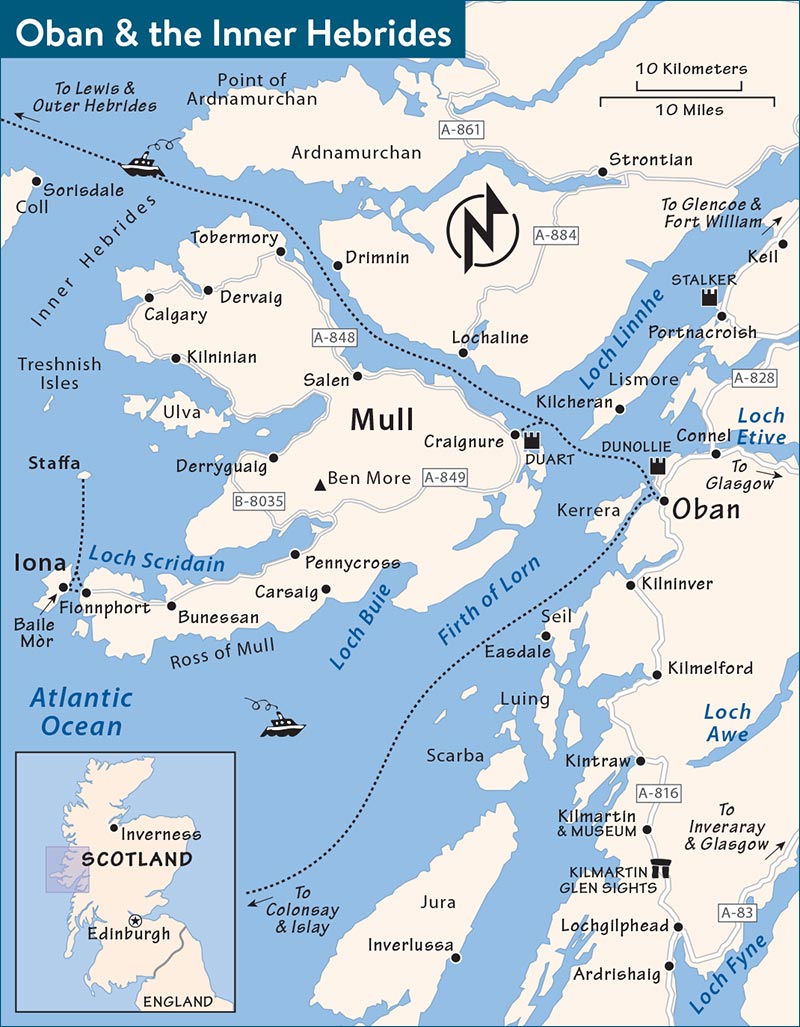
Rick’s Tip: The best interior seats on the Oban-Mull ferry—with the biggest windows—are in the sofa lounge on the “observation deck” (level 4) at the back end of the boat. (Follow signs for the toilets, and look for the big staircase to the top floor).
The ferry has a fine cafeteria with hot meals and packaged sandwiches, a small snack bar on the top floor (hot drinks and basic sandwiches), and a bookshop. If it’s a clear day, ask a local or a crew member to point out Ben Nevis, the tallest mountain in Britain. Five minutes before landing on Mull, you’ll see the striking 13th-century Duart Castle on the left.
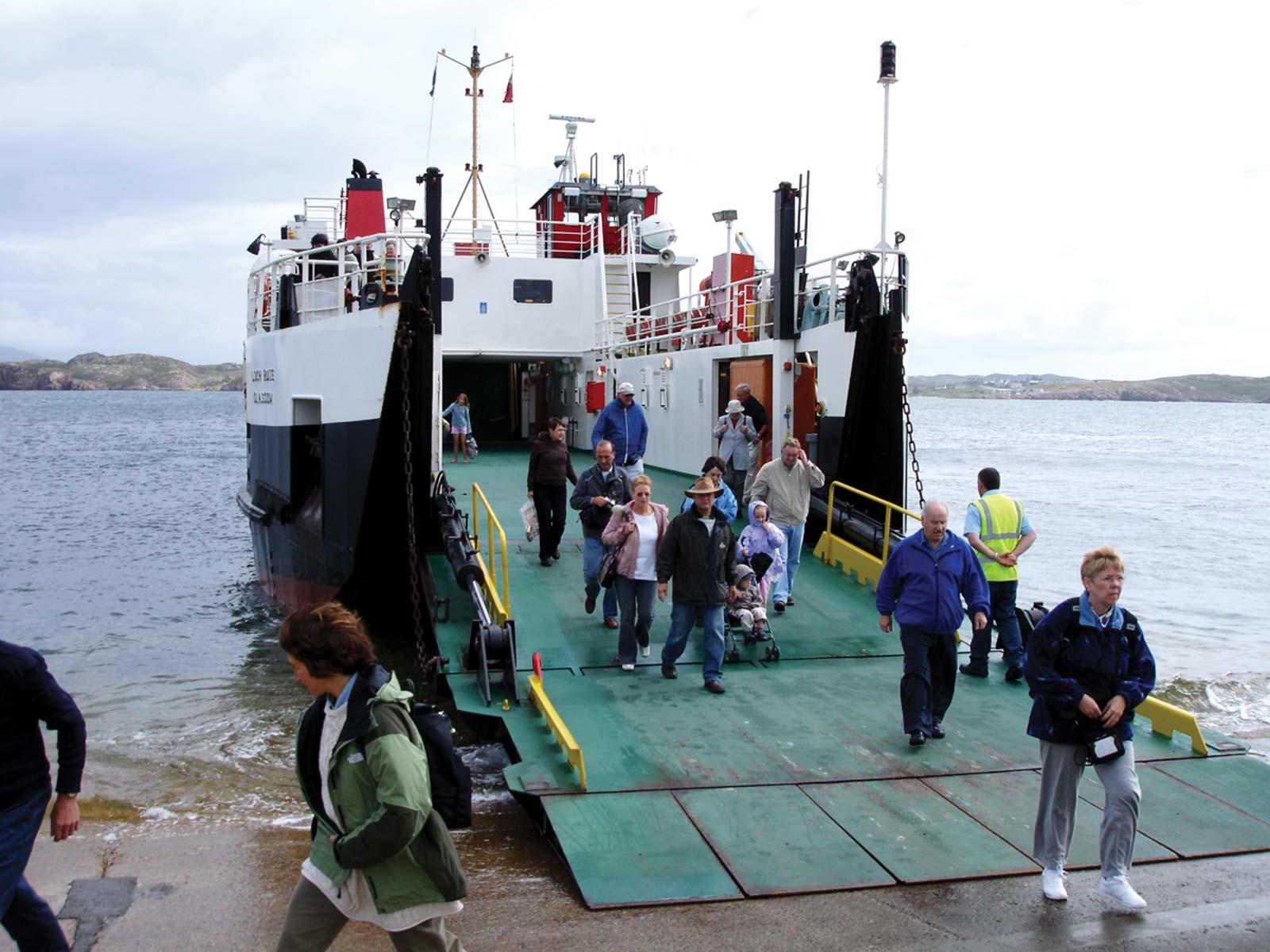
Day-tripping by ferry to the islands
Walk-on passengers disembark from deck 3, across from the bookshop (port side). Upon arrival in Mull, find your bus for the entertaining and informative ride across the Isle of Mull. The right (driver’s) side offers better sea views during the second half of the journey to Fionnphort, while the left side has fine views of Mull’s rolling wilderness. The driver spends the entire ride chattering away about life on Mull, slowing to point out wildlife, and sharing adages like, “If there’s no flowers on the gorse, snogging’s gone out of fashion.” These hardworking locals make historical trivia fascinating—or at least fun. At Fionnphort, you’ll board a small, rocking ferry to Iona. You’ll have about two hours to roam freely around the island before returning to Oban (arrives around 18:00).
By Public Transit: If you want an early start (and want to avoid some crowds), have more time on Iona, or don’t get a space on the tour described earlier, you can take the early ferry and public bus across Mull, paying individually per leg (Tue-Sat only; approximate round-trip prices: £7 for Oban-Mull ferry, £15 for public bus across Mull, £3.50 for Mull-Iona ferry).
Take the first boat of the day (departs about 7:30, buy ticket at Oban ferry terminal), then connect at Mull to bus #496 to Fionnphort (departs 8:25, 80 minutes, buy ticket from driver, no tour narration, no guarantee you’ll get to sit), then hop on the Iona ferry (every 30 minutes, buy ticket from small trailer ferry office; if closed, purchase ticket from ferry worker at the dock; cash or credit/debit cards accepted; leaving Iona, do the same, as there’s no ferry office). You’ll have about four hours on Iona and will need to return to Fionnphort in time for the bus back (15:15). It’s important to confirm all of these times locally (just pop in to the West Coast Tours office or the ferry terminal Tour Shop).
By Car: You can do this trip on your own by driving your car onto the ferry to Mull, but space is limited so book way in advance. Because of tight ferry timings, you’ll wind up basically following the tour buses anyway, you’ll miss all of the commentary, and no visitor cars are allowed on Iona (£26 round-trip for the car, plus passengers, www.calmac.co.uk).
With two extra hours, you can add a side-trip to Staffa along with your Mull/Iona visit. Like the route listed earlier, you’ll ferry from Oban to Mull, take a bus across Mull to Fionnphort, and then board a Staffa Tours boat (35-minute trip, about an hour of free time on Staffa). From Staffa you’ll head to Iona for about two hours before returning to Mull for the bus then ferry back to Oban. You can either depart on the 9:50 ferry, returning around 20:05 (£60) or do the “early bird” tour (£55, Tue-Sat only, depart at 7:30, return 18:00; book through West Coast Tours or Staffa Tours—mobile 07831-885-985, www.staffatours.com).
For a more relaxed schedule, Staffa Trips offers a guided tour with the same route as the one listed earlier, but with more time on Staffa and Iona (£60, Tue-Sat only, depart at 7:30, return 19:10, tel. 01681/700-358, www.staffatrips.co.uk).
Turus Mara offers nature/wildlife tours to just Staffa or Staffa and the small island of Ulva, departing from Oban (book at Tour Shop at Oban ferry terminal or contact Turus Mara—tel. 01688/400-242, www.turusmara.com).
The Isle of Mull, the second largest of the Inner Hebrides (after Skye), has nearly 300 scenic miles of coastline and castles and a 3,169-foot-high mountain. Called Ben More (“Big Mountain” in Gaelic), it was once much bigger. At 10,000 feet tall, it made up the entire island of Mull—until a volcano erupted. Things are calmer now, and, similarly, Mull has a noticeably laid-back population. My bus driver reported that there are no deaths from stress, and only a few from boredom.
With steep, fog-covered hillsides topped by cairns (piles of stones, sometimes indicating graves) and ancient stone circles, Mull has a gloomy, otherworldly charm. Bring plenty of rain protection and wear layers in case the sun peeks through the clouds.
On the far side of Mull, the caravan of tour buses unloads at Fionnphort, a tiny ferry town. The ferry to the island of Iona takes about 200 walk-on passengers. Confirm the return time with your bus driver, then hustle to the dock to make the first trip over (otherwise, it’s a 30-minute wait; on very busy days, those who dillydally may not fit on the first ferry). At the dock, there’s a small ferry-passenger building with a meager snack bar and a pay WC; a more enticing seafood bar is across the street. After the 10-minute ride, you wash ashore on sleepy Iona (free WC on this side), and the ferry mobs that crowded you on the boat seem to disappear up the main road and into Iona’s back lanes.
The About Mull Tours and Taxi service can get you around Mull (tel. 01681/700-507 or mobile 0788-777-4550, www.aboutmull.co.uk). They also do day tours of Mull, focusing on local history and wildlife (half-day tours also available, or ask about shorter Mull tour combined with drop-off and pick-up at Fionnphort ferry dock for quick Iona trip, minimum 2 people, must book ahead).
The tiny island of Iona, just 3 miles by 1.5 miles, is famous as the birthplace of Christianity in Scotland. If you’re on a day trip, you’ll have about two hours here on your own before you retrace your steps (your bus driver will tell you which return ferry to take back to Mull).
A pristine quality of light and a thoughtful peace pervades the stark, (nearly) car-free island and its tiny community. With buoyant clouds bouncing playfully off distant bluffs, sparkling-white crescents of sand, and lone tourists camped thoughtfully atop huge rocks just looking out to sea, Iona is a place that’s perfect for meditation. To experience Iona, it’s important to get out and take a little hike; you can follow some or all of my self-guided walk outlined later. And you can easily climb a peak—nothing’s higher than 300 feet above the sea.
The ferry arrives at the island’s only real village, Baile Mòr, with shops, a restaurant/pub, accommodations, a Spar grocery (up the road from dock, has free island maps), and no bank (get cash back with a purchase at the grocery store). The only taxi on Iona is Iona Taxi (mobile 07810-325-990, www.ionataxi.co.uk). Iona’s official website has good information (www.isle-of-iona.net).
 Iona Walk
Iona WalkHere’s a basic self-guided route for exploring Iona on foot (since no private cars are permitted unless you’re a resident or have a permit). With the standard two hours on Iona that a day trip allows, you will have time for a visit to the abbey (with a guided tour and/or audioguide) and then a light stroll; or do the entire walk described later, but skip the abbey (unless you have time for a quick visit on your way back).
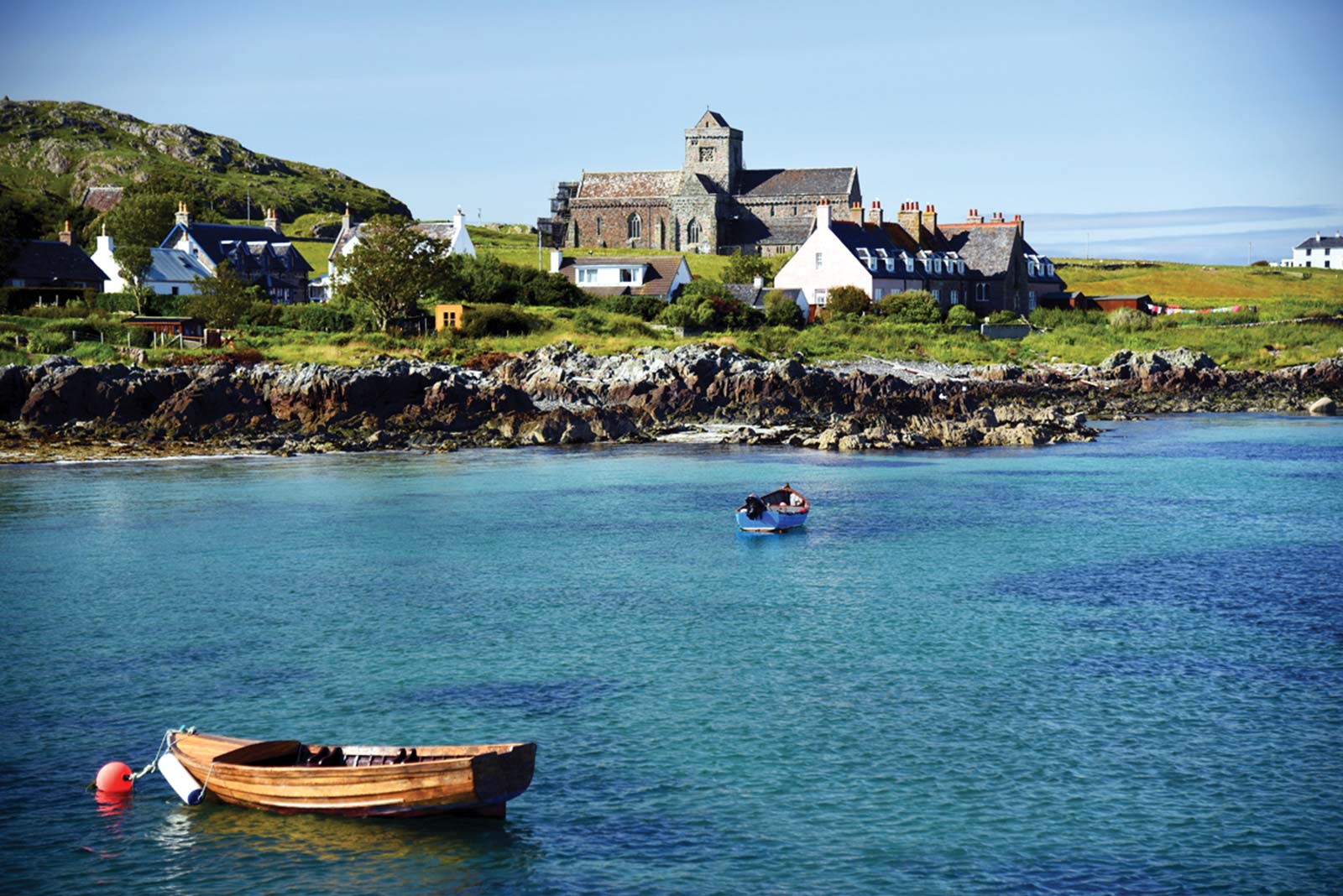
The little isle of Iona, with its big abbey
Nunnery Ruins: From the ferry dock, head directly up the single paved road that passes through the village and up a small hill to visit one of Britain’s best-preserved medieval nunneries (free).
Immediately after the nunnery, turn right on North Road. You’ll curve up through the fields—passing the parish church.
Heritage Center: This little museum, tucked behind the church (watch for signs), is small but well done, with displays on local and natural history and a tiny tearoom (free but donation requested, closed Sun and in off-season, tel. 01681/700-576, www.ionaheritage.co.uk).
St. Oran’s Chapel and Iona Abbey: Continue on North Road. After the road swings right, you’ll soon see St. Oran’s Chapel, in the graveyard of the Iona Abbey. This chapel is the oldest church building on the island. Inside you’ll find a few grave slabs carved in the distinctive Iona School style, which was developed by local stone-carvers in the 14th century. On these tall, skinny headstones, look for the depictions of medieval warrior aristocrats with huge swords. Many more of these carvings have been moved to the abbey, where you can see them in its cloister and museum.
It’s free to see the graveyard and chapel; the ▲Iona Abbey itself has an admission fee, but it’s worth the cost just to sit in the stillness of its lovely, peaceful interior courtyard (£7.50, tel. 01681/700-512, www.historicenvironment.scot—search for “Iona Abbey”).
The abbey marks the site of Christianity’s arrival in Scotland. You’ll see Celtic crosses, the original shrine of St. Columba, a big church slathered with medieval carvings, a tranquil cloister, and an excellent museum with surviving fragments of this site’s fascinating layers of history. While the present abbey, nunnery, and graveyard go back to the 13th century, much of what you’ll see was rebuilt in the 20th century.
At the entrance building, pick up your included audioguide, and ask about the good 30-minute guided tours (4/day and well worthwhile). Then head toward the church. You’ll pass two faded Celtic crosses (and the base of a third); the originals are in the museum at the end of your visit.
Facing the entrance to the church, you’ll see the original shrine to St. Columba on your left—a magnet for pilgrims.
Head inside the church. It feels like an active church—with hymnals neatly stacked in the pews—because it is, thanks to the Iona Community. While much of this space has been rebuilt, take a moment to look around. Plenty of original medieval stone carving (especially the capitals of many columns) still survives. Some of the newer features of the church—including the base of the baptismal font near the entrance, and the main altar—are carved from locally quarried Iona marble: white with green streaks.
When you’re ready to continue, find the poorly marked door into the cloister. (As you face the altar, it’s about halfway down the nave on the left, before the transept.) This space is filled with harmonious light, additional finely carved capitals (these are modern re-creations), and—displayed along the walls—several more of the tall, narrow tombstones like the ones displayed in St. Oran’s Chapel. On these, look for a couple of favorite motifs: the long, intimidating sword (indicating a warrior of the Highland clans) and the ship with billowing sails (a powerful symbol of this seafaring culture).
Around the far side of the cloister is the shop. But before leaving, don’t overlook the easy-to-miss museum. (To find it, head outside and walk around the left side of the abbey complex, toward the sea.) This modern, well-presented space exhibits a remarkable collection of original stonework from the abbey—including what’s left of the three Celtic crosses out front—all eloquently described.
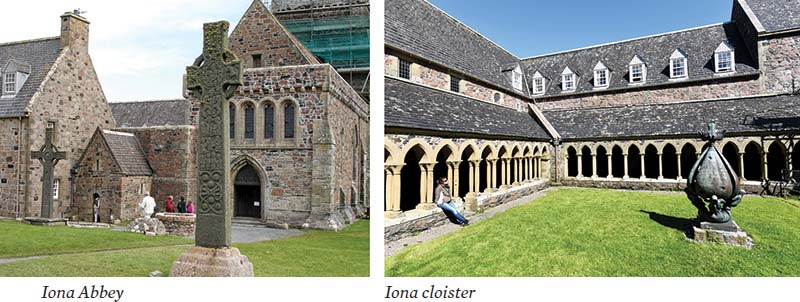
Iona Community’s Welcome Centre: Just beyond and across the road from the abbey is the Iona Community’s Welcome Centre (free WCs), which runs the abbey with Historic Scotland and hosts modern-day pilgrims who come here to experience the birthplace of Scottish Christianity. (If you’re staying longer, you could attend a worship service at the abbey—check the schedule; tel. 01681/700-404, www.iona.org.uk.) Its gift shop is packed with books on the island’s important role in Christian history.
Views: A 10-minute walk on North Road past the welcome center brings you to the footpath for Dùn Ì, a steep but short climb with good views of the abbey looking back toward Mull.
North Beach: Returning to the main road, walk another 20-25 minutes to the end of the paved road, where you’ll arrive at a gate leading through a sheep- and cow-strewn pasture to Iona’s pristine white-sand beach. Dip your toes in the Atlantic and ponder what this Caribbean-like alcove is doing in Scotland. Be sure to allow at least 40 minutes to return to the ferry dock.
Those more interested in nature than in church history will enjoy the trip to the wildly scenic Isle of Staffa. Completely uninhabited (except for seabirds), Staffa is a knob of rock draped with a vibrant green carpet of turf. Remote and quiet, it feels like a Hebrides nature preserve.
Most day trips give you an hour on Staffa—barely enough time to see its two claims to fame: The basalt columns of Fingal’s Cave, and (in summer) a colony of puffins. To squeeze in both, be ready to hop off the boat and climb the staircase. Partway up to the left, you can walk around to the cave (about 7 minutes). Or continue up to the top, then turn right and walk across the spine of the grassy island (about 10-15 minutes) to the cove where the puffins gather. (Your captain should point out both options and let you know how active the puffins have been.)
Staffa’s shore is covered with bizarre, mostly hexagonal basalt columns that stick up at various heights. It’s as if the earth were offering God his choice of thousands of six-sided cigarettes. (The island’s name likely came from the Old Norse word for “stave”—the building timbers these columns resemble.) This is the other end of Northern Ireland’s popular Giant’s Causeway. You’ll walk along the uneven surface of these columns, curling around the far side of the island, until you can actually step inside the gaping mouth of a cave—where floor-to-ceiling columns and crashing waves combine to create a powerful experience. Listening to the water and air flowing through this otherworldly space inspired Felix Mendelssohn to compose his overture, The Hebrides.
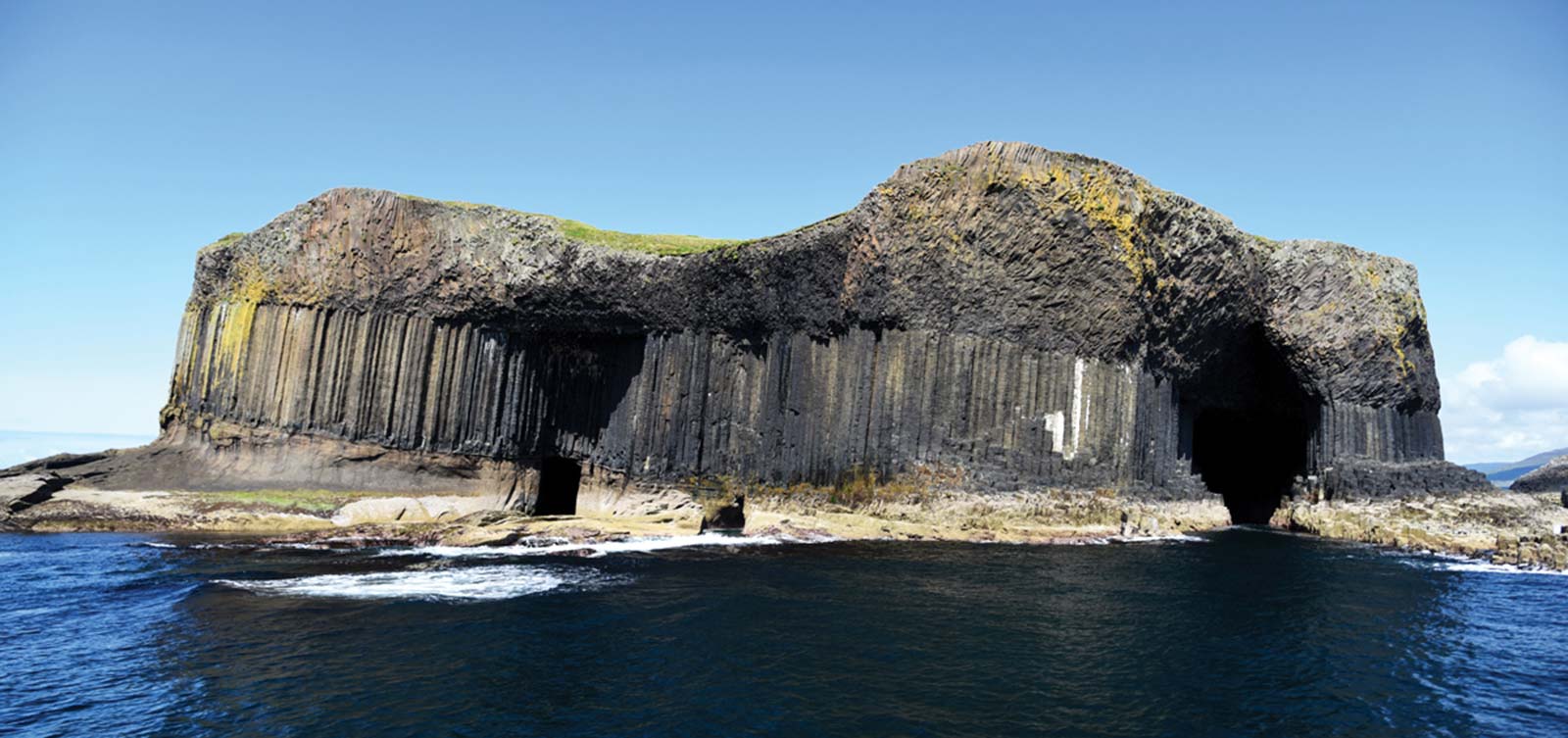
Isle of Staffa, bordered by basalt columns
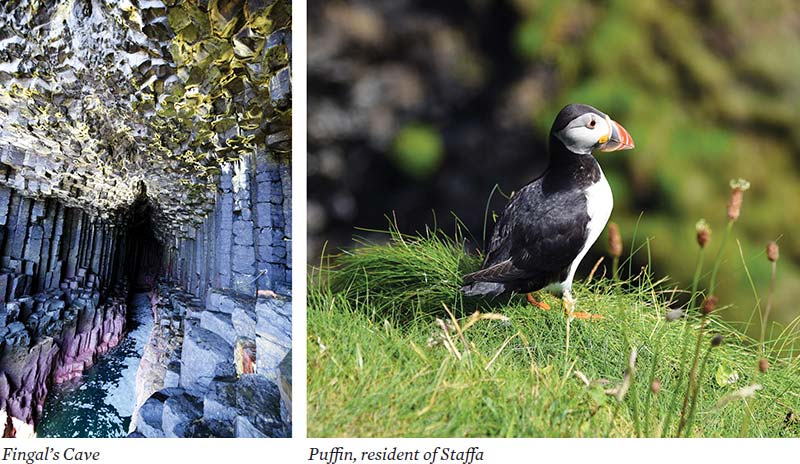
While you’re ogling the cave, consider this: These unique formations were created by volcanic eruptions more than 60 million years ago. As the surface of the lava flow quickly cooled, it contracted and crystallized into columns (resembling the caked mud at the bottom of a dried-up lakebed, but with deeper cracks). As the rock later settled and eroded, the columns broke off into the many stair-like steps that now honeycomb Staffa.
A large colony of Atlantic puffins settles on Staffa each spring and summer during mating season (generally early May through early August). The puffins tend to scatter when the boat arrives. But after the boat pulls out and its passengers hike across the island, the very tame puffins’ curiosity gets the better of them. First you’ll see them flutter up from the offshore rocks, with their distinctive, bobbing flight. They’ll zip and whirl around, and finally they’ll start to land on the lip of the cove. Sit quietly, move slowly, and be patient, and soon they’ll get close. (If any seagulls are nearby, shoo them away—puffins are undaunted by humans, who do them no harm, but they’re terrified of predator seagulls.)
In the waters around Staffa—on your way to and from the other islands—also keep an eye out for a variety of marine life, including seals, dolphins, porpoises, and the occasional minke whale, fin whale, or basking shark (a gigantic fish that hinges open its enormous jaw to drift-net plankton).
Some of Scotland’s most spectacular—and most accessible—natural wonders are in the valley called Glencoe, just an hour north of Oban. Beyond Glencoe, Fort William—a touristy transportation hub—can be a handy lunch stop.
This valley is the essence of the wild, powerful, and stark beauty of the Highlands. Along with its scenery, Glencoe offers a good dose of bloody clan history: In 1692, government Redcoats (led by a local Campbell commander) came to the valley, and they were sheltered and fed for 12 days by the MacDonalds—whose leader had been late in swearing an oath to the British monarch. Then, on the morning of February 13, the soldiers were ordered to rise up early and kill their sleeping hosts, violating the rules of Highland hospitality and earning the valley the nickname “The Weeping Glen.” Thirty-eight men were killed outright; hundreds more fled through a blizzard, and some 40 additional villagers (mostly women and children) died from exposure. It’s fitting that such an epic, dramatic incident should be set in this equally epic, dramatic valley, where the cliffsides seem to weep (with running streams) when it rains.
The most appealing town here is the sleepy one-street village of Glencoe, worth a stop for its folk museum and its status as the gateway to the valley. (The slightly larger and more modern town of Ballachulish, a half-mile away, has more services, including a grocery store.)
Day Plan: On a quick visit, this area warrants a few hours. Wander through Glencoe village, tour its modest museum, then drive up Glencoe valley for views. But if you have a day or two to linger in the Highlands, Glencoe is an ideal place to do it. Settle in for a night (or more) to make time for a more leisurely drive and to squeeze in a hike or two.
Getting There: For drivers, the valley of Glencoe is an easy side-trip just off the main A-828/A-82 road between Oban and points north (such as Fort William and Inverness). If you’re coming from the north, the signage can be tricky—at the roundabout south of Fort William, follow signs to Crianlarich and A-82.
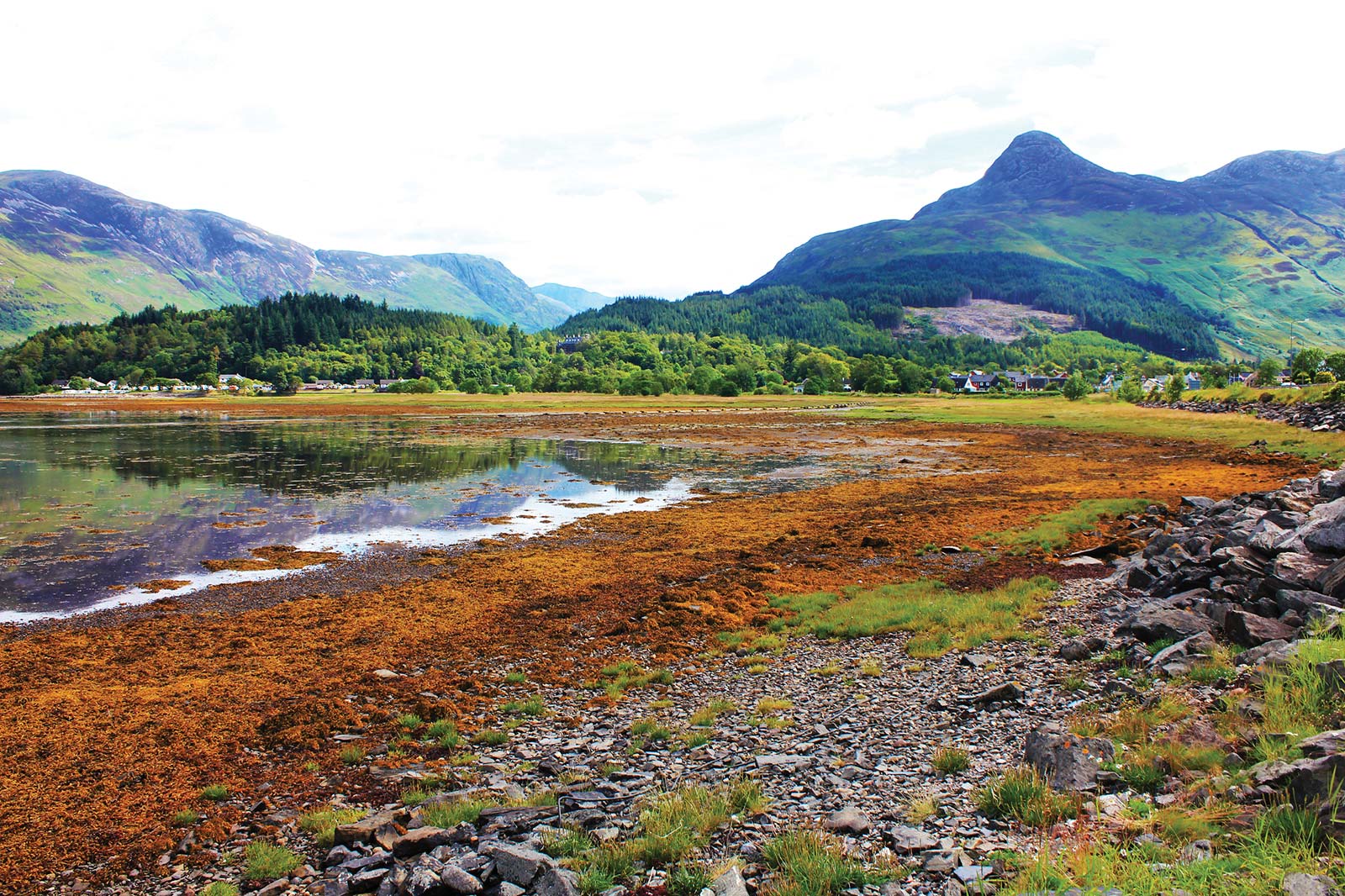
Glencoe Valley
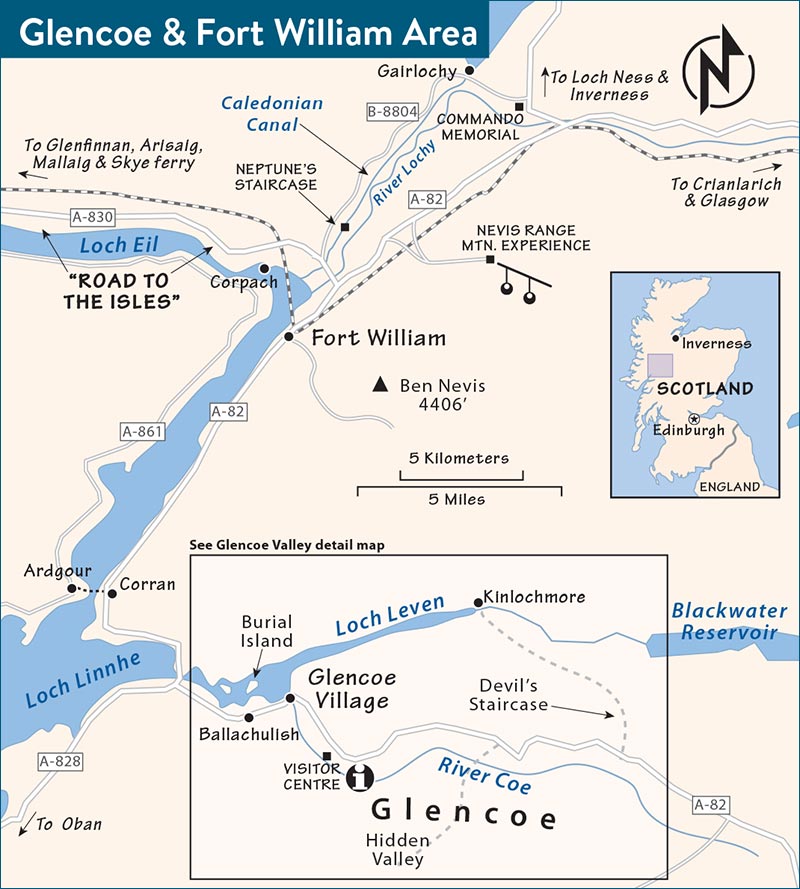
Citylink buses #914, #915, or #916 stop at Glencoe Crossroads (a short walk to village center) and nearby Ballachulish, heading north to Fort William (8/day, 30 minutes) or south to Glasgow (2.5 hours). Stagecoach bus #44 runs from either Glencoe Crossroads or Ballachulish to Fort William (hourly, fewer on Sun). From Ballachulish, you can take Citylink bus #918 to Oban (2/day, 1 hour).
Tourist Information: Your best source of information—especially for walks and hikes—is the Glencoe Visitor Centre (described under “Sights”). The nearest TI is in the next town, Ballachulish (buried inside a huge gift shop, open daily, tel. 01855/811-866, www.glencoetourism.co.uk). For more information on the area, see www.discoverglencoe.com.
GLENCOE AND NORTH LORN FOLK MUSEUM
Glencoe village is just a line of houses sitting beneath the brooding mountains. The town’s hub of activity is its grocery store (with an ATM, open daily). The only real sight in town is the folk museum (described next). But walking the main street gives a good glimpse of village Scotland. From the free parking lot at the entrance to town, go for a stroll. You’ll pass lots of little B&Bs renting two or three rooms, the stony Episcopal church, the folk museum, the town’s grocery store, and the village hall.
Rick’s Tip: For a hike right from Glencoe village, cross the bridge in town and continue straight up to Glencoe Lochan (follow signs)—it’s a 20-minute uphill walk. Once there, a helpful orientation panel suggests three one-mile walking loops—mostly around the beautiful lake.
This gathering of thatched-roof, early 18th-century croft houses is a volunteer-run community effort. It’s jammed with local history, creating a huggable museum filled with humble exhibits gleaned from the town’s closets and attics. Be sure to look for the museum’s little door that leads out back, where additional, smaller buildings are filled with everyday items (furniture, farm tools, and so on) and more exhibits (£3, Easter-Sept Mon-Sat 10:00-16:30, closed Sun and off-season, tel. 01855/811-664, www.glencoemuseum.com).
This modern facility, a mile past Glencoe village up the A-82 into the dramatic valley, is designed to resemble a clachan, or traditional Highland settlement. The information desk inside the shop at the ranger desk is your single best resource for advice (and maps or guidebooks) about local walks and hikes. At the back of the complex you’ll find a viewpoint with a handy 3-D model of the hills for orientation. There’s also a pricey exhibition about the surrounding landscape, the region’s history, wildlife, mountaineering, and conservation. It’s worth the time to watch the more-interesting-than-it-sounds two-minute video on geology and the 14-minute film on the Glencoe Massacre, which thoughtfully traces the events leading up to the tragedy rather than simply recycling romanticized legends (free, exhibition-£6.50; April-Oct daily 9:30-17:30; Nov-March Thu-Sun 10:00-16:00, closed Mon-Wed; free Wi-Fi, café, tel. 01855/811-307, www.glencoe-nts.org.uk).
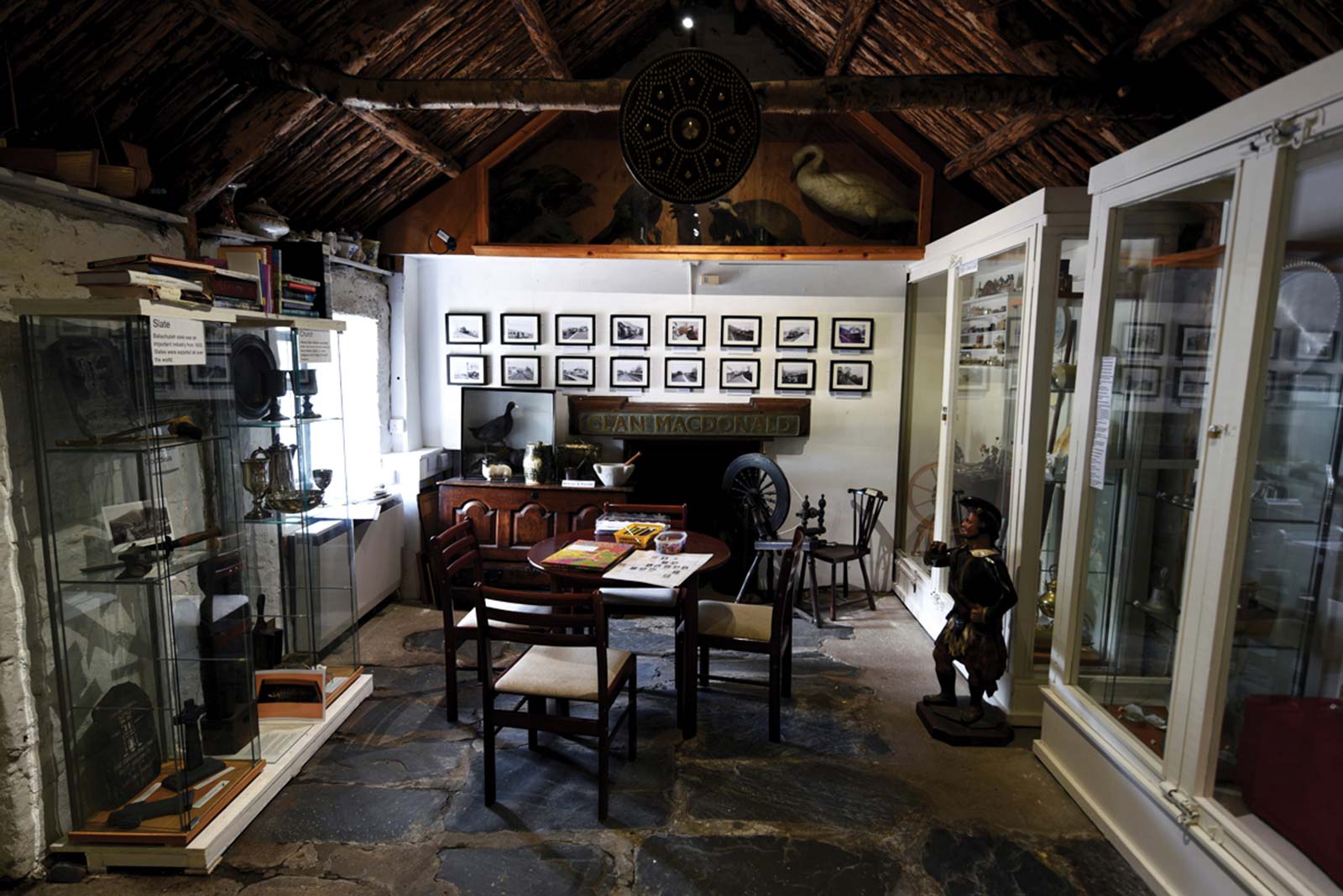
Glencoe and North Lorn Folk Museum
If you have a car, spend an hour or so following the A-82 through the valley, past the Glencoe Visitor Centre, up into the desolate moor beyond, and back again. You’ll enjoy grand views, dramatic craggy hills, and, if you’re lucky, a chance to hear a bagpiper in the wind. Roadside Highland buskers often set up here on good-weather summer weekends.
If you’re up for a hike, I’ve pointed out trailheads along the way. Many routes are not particularly well marked, so it’s essential to get very specific instructions (from the rangers at the Glencoe Visitor Centre) and equip yourself with a good map (the Ordnance Survey Explorer Map #384, sold at the center).
 Self-Guided Driving Tour: Leaving Glencoe village on the A-82, it’s just a mile to the Glencoe Visitor Centre (on the right). Soon after, the road pulls out of the forested hills and gives you unobstructed views of the U-shaped valley.
Self-Guided Driving Tour: Leaving Glencoe village on the A-82, it’s just a mile to the Glencoe Visitor Centre (on the right). Soon after, the road pulls out of the forested hills and gives you unobstructed views of the U-shaped valley.
About a mile after the visitors center, on the left, is a parking lot for Signal Rock and An Torr, a popular place for easy-to-moderate forested hikes (a panel at the trailhead describes your options). Just beyond, also on the left, is a single-track road leading to the recommended Clachaig Inn, a classic hikers’ pub.
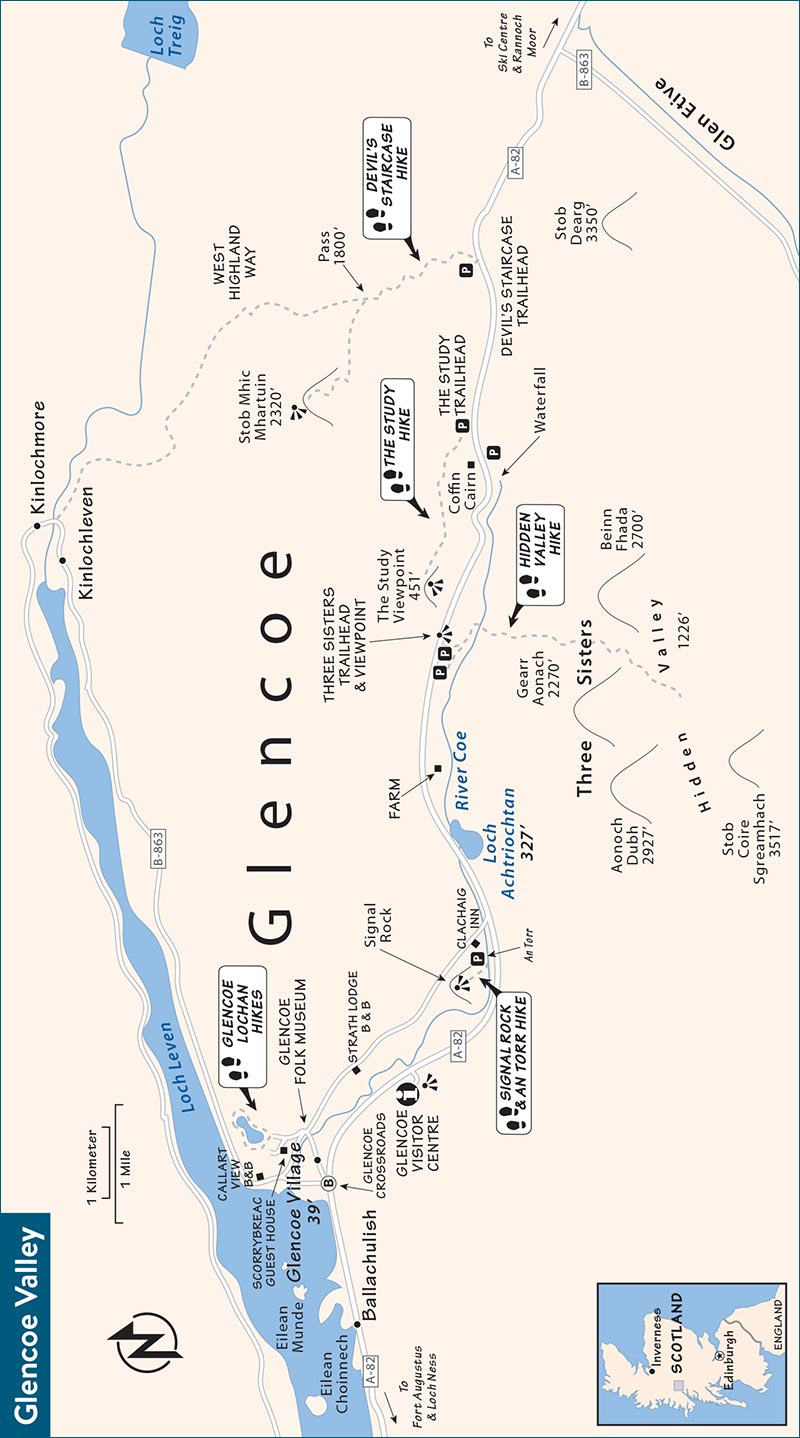
Continuing along the A-82, you’ll hit a straight stretch, passing a lake (Loch Achtriochtan), and then a small farm, both on the right. After the farm, the valley narrows a bit as you cut through Glencoe Pass. On the right, you’ll pass two small parking lots. Pull into the second one for perhaps the best viewpoint of the entire valley, with point-blank views (directly ahead) of the steep ridge-like mountains known as the Three Sisters. Hike about 100 feet away from the pullout to your own private bluff to enjoy the view alone. This is also the starting point for the Hidden Valley hike.
As you continue your drive, you’ll pass a raging waterfall in a canyon—the Tears of the MacDonalds—on the right. After another mile or so—through more glorious waterfall scenery—watch on the left for the Coffin Cairn, which looks like a stone igloo (parking is just across the road if you want a photo op). Just after the cairn, look on the left for pullout parking for the easy-to-moderate hike to The Study, a viewpoint overlooking the road you just drove down (about 45-60 minutes round-trip).
After this pullout, you’ll hit a straightaway for about a mile, followed by an S-curve. At the end of the curve, look for the pullout parking on the left, just before the stand of pine trees. This is the trailhead for the Devil’s Staircase hike, high into the hills (a strenuous 800-foot gain to the pass at the top, about 1.5 hours round-trip).
Continuing past here, you’re nearing the end of the valley. The intimidating peak called the Great Shepherd of Etive (on the right) looms like a dour watchman, guarding the far end of the valley. Soon you’ll pass the turnoff (on the right) for Glen Etive, an even more remote-feeling valley. Continuing past that, the last sign of civilization (on the right) is the Glencoe Ski Centre. And from here, the terrain flattens out as you enter the vast Rannoch Moor—50 bleak square miles of heather, boulders, and barely enough decent land to graze a sheep. Robert Louis Stevenson called it the “Highland Desert.”
You could keep driving as far as you like—but the moor looks pretty much the same from here on out. Turn around and head back through Glencoe...it’s scenery you’ll hardly mind seeing twice.
In the village, $$$ The Glencoe Gathering specializes in seafood with a Scottish twist (daily, at junction of A-82 and Glencoe village), and the $ Glencoe Café has soups, sandwiches, and homemade baked goods (daily). Set in a stunning valley a few miles from the village, $$ Clachaig Inn serves solid pub grub all day long.
These B&Bs are along or just off the main road through the middle of the village: $$ Beechwood Cottage B&B, a shoes-off, slippers-on kind of place (www.beechwoodcottage.scot); the welcoming $$ Heatherlea B&B (www.heatherleaglencoe.com); and the cozy and homey $ Ghlasdruim B&B (http://ghlasdruim.co.uk).
Options just outside town, with good proximity to both the village and valley, include the comfortable $$ Strath Lodge (www.strathlodgeglencoe.com) and the hiker-friendly $$ Clachaig Inn (with recommended pub, frontdesk@clachaig.com).
Fort William—after Inverness, the second biggest town in the Highlands (pop. 10,000)—is Glencoe’s opposite. While Glencoe is a humble one-street village, appealing to hikers and nature lovers, Fort William feels like one big Scottish shopping mall. But given its strategic position—between Glencoe and Oban in the south, Inverness in the east, and the Isle of Skye in the west—you’re likely to pass through Fort William at some point during your Highlands explorations.
While “just passing through” is the perfect plan here, Fort William can provide a good opportunity to stock up on whatever you need (last supermarket before Inverness), grab lunch, and get any questions answered at the TI.
Arrival in Fort William: Parking lots flank the main pedestrian zone, High Street. The train and bus stations sit side by side just north of the old town center, where you’ll find a handy pay parking lot.
Tourist Information: The TI is on the car-free main drag (daily, free Wi-Fi, 15 High Street, tel. 01397/701-801). Free public WCs are up the street, next to the parking lot.
Fort William’s only real sight is its humble but well-presented museum. Its exhibits are genuinely insightful about local history and Highland life.
Cost and Hours: Free, £3 suggested donation, Mon-Sat 10:00-17:00, and maybe Sun in high season; Nov-Dec and March until 16:00, closed Sun; closed Jan-Feb; midway down the main street on Cameron Square, www.westhighlandmuseum.org.uk).
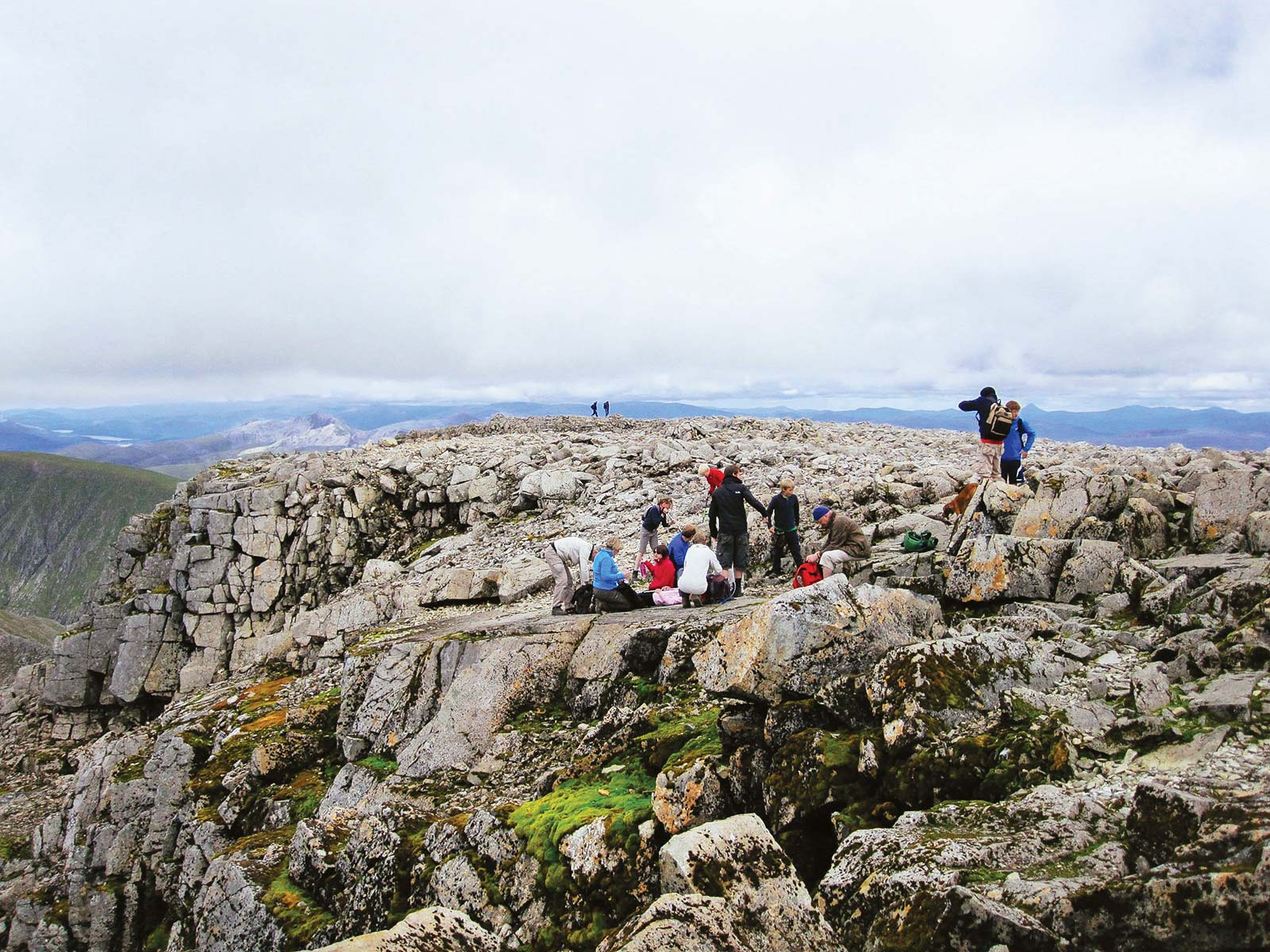
On top of Ben Nevis, Britain’s highest peak
From Fort William, take a peek at Britain’s highest peak, Ben Nevis (4,406 feet). Thousands walk to its summit each year. On a clear day, you can admire it from a distance. Scotland’s only mountain cable cars—at the Nevis Range Mountain Experience—can take you to a not-very-lofty 2,150-foot perch on the slopes of Aonach Mòr for a closer look (£14, 15-minute ride, generally open daily but closed in high winds and winter—call ahead, signposted on the A-82 north of Fort William, tel. 01397/705-825, www.nevisrange.co.uk).
For lunch and picnics, try $ Deli Craft (61 High Street) or $ Hot Roast Company (127 High Street). For lunch or dinner, $$ The Grog & Gruel serves real ales, good pub grub, and Tex-Mex/Cajun dishes (66 High Street).
If spending the night, the Hobbit-cute $ Gowan Brae B&B (“Hill of the Big Daisy”) has loch or garden views (Union Road, www.gowanbrae.co.uk).
Fort William is a major transit hub for the Highlands.
From Fort William to: Glencoe or Ballachulish (all Glasgow-bound buses—#914, #915, and #916; 8/day, 30 minutes; also Stagecoach bus #44, hourly, fewer on Sun), Oban (bus #918, 2/day, 1.5 hours), Portree on the Isle of Skye (buses #914, #915, and #916, 3/day, 3 hours), Inverness (buses #19 and #919, 7/day, 2 hours), Glasgow (buses #914, #915, and #916; 8/day, 3 hours). To reach Edinburgh, take the bus to Glasgow, then transfer to a train or bus (figure 5 hours total).
From Fort William to: Glasgow (3/day, 4 hours), Mallaig/ferry to Isle of Skye (4/day, 1.5 hours; take 30-minute ferry to Armadale, where Stagecoach bus #52 connects to destinations on Skye).
From Fort William to Loch Ness and Inverness: Head north out of Fort William on the A-82. After about eight miles, in the village of Spean Bridge, take the left fork (staying on the A-82). The A-82 sweeps north and follows the Caledonian Canal, passing through Fort Augustus (a good lunch stop, with its worthwhile Caledonian Canal Visitor Centre), and then follows the north side of Loch Ness on its way to Inverness.
From Oban to Fort William via Glencoe: See here in the Oban chapter.
From Fort William to the Isle of Skye: You have two options: Head north on the A-82 to Invergarry, and turn left (west) on the A-87, which you’ll follow to Kyle of Lochalsh and the Skye Bridge to the island.
Or, head west on the A-830 through Glenfinnan, then catch the ferry from Mallaig to Armadale on the Isle of Skye. The scenic drive between Fort William and Mallaig is called the “Road to the Isles.” Be sure you allow enough time to make it to Mallaig at least 20 minutes before the Skye ferry departs (figure at least 90 minutes of driving time from Fort William to the ferry, not including stops). In summer it’s smart to reserve a spot on the ferry the day before, either online or by phone. For specifics, see “Arriving and Departing” at the end of the Isle of Skye chapter.